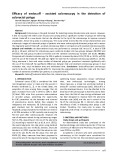
HUE JOURNAL OF MEDICINE AND PHARMACY ISSN 3030-4318; eISSN: 3030-4326 185
Hue Journal of Medicine and Pharmacy, Volume 14, No.6/2024
Efficacy of endocuff - assisted colonoscopy in the detection of
colorectal polyps
Tran Thi Thuy Tien1, Nguyen Thi Huyen Thuong2, Tran Van Huy1*
(1) University of Medicine and Pharmacy, Hue University
(2) Hue University of Medicine and Pharmacy Hospital
Abstract
Background: Colonoscopy is the gold standard for detecting colorectal adenomas and cancers. However,
it fails to visualize the entire colon mucosa and consequently a significant number of polyps are still being
missed. Endocuff is a new device that can be attached to the tip of the colonoscope to improve mucosal
visualization, hence the quality in colonoscopy. This study aimed to describe the clinical characteristics and
endoscopic images of colorectal polyps of patients who were endoscopically detected polyps and to assess
the diagnostic yield of Endocuff – assisted colonoscopy (EAC) in comparison with standard colonoscopy (SC).
Subjects and methods: An observational study was performed to compare EAC versus SC. A total of 308
adults ≥ 18 years referred for colonoscopy were randomly divided into two groups between 06/2022 and
07/2023, the EAC group included 154 adults and the standard colonoscopy included 154 adults. Results:
Compared with standard colonoscopy, the PDR in patients increased by about 11% (70.1% vs. 59.1%, p<0.05)
with the use of the Endocuff. The ADR was higher for EAC than for standard colonoscopy (20.8% vs. 16.2%).
Polyp, adenoma ≤ 5mm and mean number of detected polyps per procedure increased significantly with
the use of the Endocuff. No significant differences between EAC and standard colonoscopy groups in ileal
intubation rate, cecal intubation time and withdrawal time. Conclusions: Endocuff-assisted colonoscopy
seems to be safe and may bring benefits for improving the polyp/adenoma detection rates and the mean
number of adenomas identified per patient, as compared with SC.
Keywords: Endocuff; adenoma detection rate; colonoscopy; colorectal polyps.
Corresponding Author: Tran Van Huy. Email: tvhuy@huemed-univ.edu.vn
Received: 25/9/2024; Accepted: 14/11/2024; Published: 25/12/2024
DOI: 10.34071/jmp.2024.6.26
1. INTRODUCTION
Colorectal cancer (CRC) is considered the third
most diagnosed cancer in males and the second in
females worldwide [1, 2]. In the United States, the
proportion of cases among those younger than 55
years increased from 11% in 1995 to 20% in 2019
[3] Most CRCs arise from precursor adenomatous
or serrated polyps, presenting the opportunity
for CRC prevention via the detection and removal
of precancerous lesions before they progress to
malignancy and metastasis [4] Colonoscopy is the
gold standard tool for detecting and removing
neoplastic polyps [5] Adenoma resection can lead to
a 53-70% reduction in CRC mortality rate during the
first ten years after colonoscopy [6]. However, the
rate of adenoma missed during colonoscopy ranges
from 6-27%, depending on the size of the adenoma
[7]. According to research by Luz B.S.R. et al. (2021),
the overall adenoma miss rate when using standard
colonoscopy (SC) was 47.4% [6]; besides, Shunsuke
Kamba et al. (2021 reported that the adenoma miss
rate of SC was 36.7% and the polyp miss rate was
40.6% [8]. Many measures have been proposed to
reduce the rate of missing colorectal polyps, including
optimizing bowel preparation, slower withdrawal
time, new endoscopic technologies… Among
these measures, a simple but promising method is
Endocuff - assisted colonoscopy (EAC). Endocuff is a
recently developed device, it can be attached to the
distal tip of the colonoscope to hold the colonic folds
away from the field of view during withdrawal and
has been designed to improve both the adenoma
detection rate (ADR) and the user’s control of the
tip of the colonoscope [9]. In Vietnam, data about
the efficacy of EAC in detecting colon polyps is still
limited. Therefore, this study aims to assess the
diagnostic yield of EAC in comparison with standard
colonoscopy.
2. MATERIAL AND METHODS
Study design and participants
An observational study was conducted at the
Gastroenterology and Endoscopy Center of the Hue
University of Medicine and Pharmacy Hospital from
June 2022 to July 2023.
All patients ≥ 18 years who were presented for
colonoscopy at this hospital were considered for
recruitment to the trial. We considered experienced






















